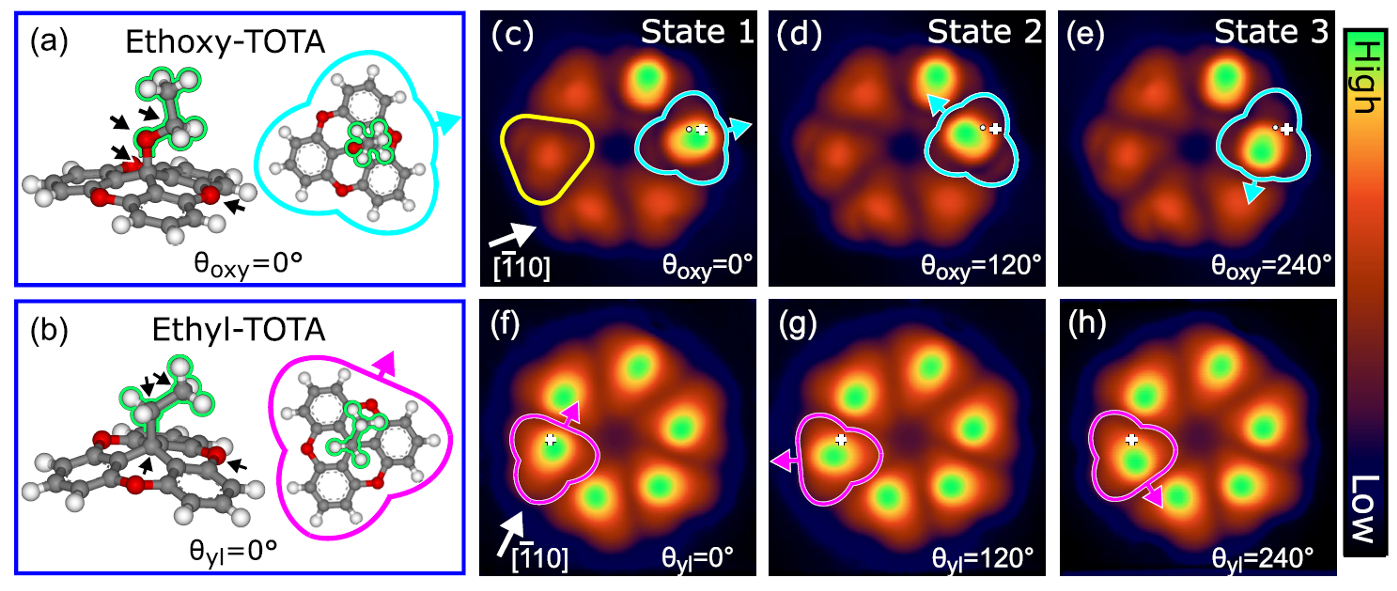Controlled molecular rotors mounted on a molecular platform on a gold substrate
The Nobel Prize in Chemistry 2016 was awarded to Jean-Pierre Sauvage, Fraser Stoddart and Ben Feringa “for the design and synthesis of molecular machines”. Molecular machines are made by one or a few molecules linked together, comprising several hundred atoms. If a molecule can use an energy input to perform a mechanical movement (output) it is termed molecular machine. But this is extremely challenging because molecules tend to move, spin, and rotate randomly, taking energy from the environment. So they have to be designed -and then synthesized- to move in a controlled way. That is precisely what the winners of the Nobel Prize in Chemistry pioneered and excelled at.
As in the macroscopic world, where we have wheels, cogs, and other rotating things as fundamental pieces of our machines, molecular rotors have attracted considerable interest for their prospects in nanotechnology. But one thing is having a molecule with the possibility of rotating and another one to fix it on a solid substrate maintaining intact that capacity.
Rotor molecules deposited on surfaces may be investigated at a submolecular scale using scanning tunnelling microscopy (STM). The compounds that can be studied this way are either adsorbates which are molecular rotors themselves and the substrate is used as a stator, or the stator and the rotor are subunits of the same molecule. Besides rotors there are also rotary switches that alternate between two rotation angles and consequently do not enable studies on the directionality of the motion, which is essential for using a rotor in a motor.
As we mentioned, the adsorption of molecules on surfaces often modifies their gas-phase properties. While these modifications may be beneficial, for example, by inducing an asymmetry, which is essential for the directionality of the rotation, they make the predictions of the on-surface properties of a molecule much more difficult to do.

Now, a team of researchers investigates 1 the switching of two closely-related three-state rotors (ethoxy- and ethyl- molecular stepper motors) designed to work mounted on a gold Au(111) substrate using tunnelling electrons provided by low-temperature STM. Density functional theory calculations complete the model study.
In contrast to previous studies, the researchers use a rigid and planar molecular platform, trioxatriangulenium (TOTA), as anchor rather than using single atoms like sulphur or flexible molecular subunits. In this case, the platform serves as stator, separates the rotor from the substrate and provides an electronic decoupling because it binds to gold surfaces via van der Waals Forces instead of chemical bonds of most platforms.
The scientist find that this approach preserves important gas-phase properties of the molecules, such as the rotational energy barriers and the vibrational modes involved in rotation. This simplifies a detailed analysis, and permits, for instance, the identification of those vibrational modes involved in the rotation process.
The team shows that inelastic electron tunnelling excites the relevant vibrations, which in turn switch the orientation of the rotors. Although the molecules are achiral, directionality of the rotational steps is induced and controlled through the interaction with the STM tip or neighbouring adsorbates. The electronic decoupling provided by the platform is found to effectively increase the switching yield of the rotor, and may lead to longer lifetime of electronic excited states of the rotor, which would be useful to control the rotation by light.
Author: César Tomé López is a science writer and the editor of Mapping Ignorance
Disclaimer: Parts of this article may be copied verbatim or almost verbatim from the referenced research paper.
References
- Torben Jasper-Toennies, Manuel Gruber, Sven Johannsen, Thomas Frederiksen, Aran Garcia-Lekue, Torben Jäkel, Fynn Roehricht, Rainer Herges, and Richard Berndt (2020) ACS Nano doi: 10.1021/acsnano.0c00029 ↩